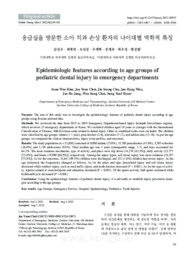

PARTNER
검증된 파트너 제휴사 자료
응급실을 방문한 소아 치과 손상 환자의 나이대별 역학적 특징 (Epidemiologic features according to age groups of pediatric dental injury in emergency departments)
8 페이지
최초등록일 2025.06.01
최종저작일
2022.12

-
미리보기
서지정보
· 발행기관 : 대한소아응급의학회
· 수록지 정보 : 대한소아응급의학회지 / 9권 / 2호 / 95 ~ 102페이지
· 저자명 : 김선우, 최재연, 조진성, 우재혁, 장재호, 최우성, 현성열
초록
Purpose: The aim of this study was to investigate the epidemiologic features of pediatric dental injury according to age groups using Korean national data.
Methods: We reviewed the data from 2015 to 2019 Emergency Department-based Injury In-depth Surveillance registry, which involves 23 emergency departments in Korea. We included children aged 18 years or younger with the International Classification of Disease, 10th Revision codes related to dental injury. Other or combined codes were excluded. The children were classified by age groups: infants (< 1 year), preschoolers (2-6), schoolers (7-12), and adolescents (13-18). As per the age groups, we compared the clinical characteristics, injury event profiles, and outcomes.
Results: The study population (n = 33,020) consisted of 8,900 infants (27.0%), 15,705 preschoolers (47.6%), 5,295 schoolers (16.0%), and 3,120 adolescents (9.4%). Their median age was 3 years (interquartile range, 1-7), and boys accounted for 64.2%. The most common mechanism, type of activity, and place were slip down (14,274 [43.2%]), daily activity (23,777 [72.0%]), and home (19,980 [60.5%]), respectively. Among the injury types, soft tissue injury was most common (24,357 [73.8%]). As for the outcomes, 32,841 (99.5%) children were discharged, and 332 (1.0%) children had severe injury. As the age increased, the frequencies changed as follows. As for the place and type, household injury and soft tissue injury decreased while outdoor injury, such as road traffic injury, and tooth fracture increased (P < 0.001). As for the type of activity, injuries related to exercise/sports and education increased (P < 0.001). Of the sports activity, ball sports increased while kickboard/cycle decreased (P < 0.001).
Conclusion: Using the epidemiologic features of pediatric dental injury, it is advisable to establish injury prevention strategies according to the age groups.영어초록
Purpose: The aim of this study was to investigate the epidemiologic features of pediatric dental injury according to age groups using Korean national data.
Methods: We reviewed the data from 2015 to 2019 Emergency Department-based Injury In-depth Surveillance registry, which involves 23 emergency departments in Korea. We included children aged 18 years or younger with the International Classification of Disease, 10th Revision codes related to dental injury. Other or combined codes were excluded. The children were classified by age groups: infants (< 1 year), preschoolers (2-6), schoolers (7-12), and adolescents (13-18). As per the age groups, we compared the clinical characteristics, injury event profiles, and outcomes.
Results: The study population (n = 33,020) consisted of 8,900 infants (27.0%), 15,705 preschoolers (47.6%), 5,295 schoolers (16.0%), and 3,120 adolescents (9.4%). Their median age was 3 years (interquartile range, 1-7), and boys accounted for 64.2%. The most common mechanism, type of activity, and place were slip down (14,274 [43.2%]), daily activity (23,777 [72.0%]), and home (19,980 [60.5%]), respectively. Among the injury types, soft tissue injury was most common (24,357 [73.8%]). As for the outcomes, 32,841 (99.5%) children were discharged, and 332 (1.0%) children had severe injury. As the age increased, the frequencies changed as follows. As for the place and type, household injury and soft tissue injury decreased while outdoor injury, such as road traffic injury, and tooth fracture increased (P < 0.001). As for the type of activity, injuries related to exercise/sports and education increased (P < 0.001). Of the sports activity, ball sports increased while kickboard/cycle decreased (P < 0.001).
Conclusion: Using the epidemiologic features of pediatric dental injury, it is advisable to establish injury prevention strategies according to the age groups.참고자료
· 없음태그
-
자주묻는질문의 답변을 확인해 주세요

꼭 알아주세요
-
자료의 정보 및 내용의 진실성에 대하여 해피캠퍼스는 보증하지 않으며, 해당 정보 및 게시물 저작권과 기타 법적 책임은 자료 등록자에게 있습니다.
자료 및 게시물 내용의 불법적 이용, 무단 전재∙배포는 금지되어 있습니다.
저작권침해, 명예훼손 등 분쟁 요소 발견 시 고객센터의 저작권침해 신고센터를 이용해 주시기 바랍니다. -
해피캠퍼스는 구매자와 판매자 모두가 만족하는 서비스가 되도록 노력하고 있으며, 아래의 4가지 자료환불 조건을 꼭 확인해주시기 바랍니다.
파일오류 중복자료 저작권 없음 설명과 실제 내용 불일치 파일의 다운로드가 제대로 되지 않거나 파일형식에 맞는 프로그램으로 정상 작동하지 않는 경우 다른 자료와 70% 이상 내용이 일치하는 경우 (중복임을 확인할 수 있는 근거 필요함) 인터넷의 다른 사이트, 연구기관, 학교, 서적 등의 자료를 도용한 경우 자료의 설명과 실제 자료의 내용이 일치하지 않는 경우
“대한소아응급의학회지”의 다른 논문도 확인해 보세요!
-
Intestinal obstruction caused by acute perforated appendicitis misdiag.. 5 페이지
Symptomatic abdominal distension in young children requires a differential diagnosis, such as overeating, constipation or surgical emergency. If the distension is associated with intestinal obstructio.. -
한국 분만실 내 신생아 소생술 준비 상태에 관한 실태 조사 6 페이지
Purpose: We aimed to survey current status of preparedness for neonatal resuscitation in delivery rooms in Korea. Methods: We analyzed data regarding preparedness for the resuscitation in terms of per.. -
Association between the Korean Triage and Acuity Scale level and sever.. 7 페이지
Purpose: Triage tools play a vital role in classifying the severity of children in emergency departments (EDs). We investigated the association between the Korean Triage and Acuity Scale (KTAS) and se.. -
Necrotizing fasciitis due to late-onset group B streptococcal bacterem.. 5 페이지
Necrotizing fasciitis (NF) is a severe soft tissue infection, characterized by rapid and fulminant progression. Thus, early suspicion, and prompt medical and aggressive surgical management are importa.. -
중증급성호흡증후군 코로나바이러스-2 및 다른 호흡기 바이러스에 의한 크루프의 임상적 특성: 오미크론 변이(B.1.1.529)가.. 5 페이지
Purpose: Croup is a clinical manifestation of coronavirus disease 2019 (COVID-19) in children. The Omicron variant of severe acute respiratory syndrome coronavirus 2 usually causes an upper respirator..
문서 초안을 생성해주는 EasyAI
